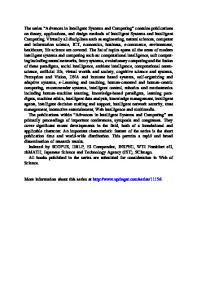Primality and Factoring
There are many situations where one wants to know if a large number n is prime. For example, in the RSA public key cryptosystem and in various cryptosystems based on the discrete log problem in finite fields, we need to find a large “random” prime.
- PDF / 25,511,489 Bytes
- 245 Pages / 439.37 x 666.142 pts Page_size
- 104 Downloads / 336 Views
114
Editorial Board F.W. Gehring K.A. Ribet
Springer Science+ Business Media, LLC
Neal Koblitz
A Course in Number Theory and Cryptography Second Edition
Springer
Ne al Koblitz Department of Mathematics University of Washington Seattle, WA98l95 USA
Editorial Board: S. Axler Mathematics Department San Francisco State University San Francisco, CA 94132 USA [email protected]
F. W. Gehring Mathematics Department East Hali University of Michigan Ann Arbor, MI 48109 USA [email protected]
K. A. Ribet Mathematics Department University of California, Berkeley Berkeley, CA 94720-3840 USA [email protected]
Mathematics Subject Classification (2000): II-OI, 11T71 With 5 I1Iustrations.
Library of Congress Cataloging-in-Publication Data Koblitz, Neal, 1948A Course in number theory and cryptography / Neal Koblitz. - 2nd ed. p. cm. - (Graduate texts in mathematics ; 114) Includes bibliographical references and index. ISBN 978-1-4612-6442-2 ISBN 978-1-4419-8592-7 (eBook) DOI 10.1007/978-1-4419-8592-7 1. Number theory. 2. Cryptography. 1. Title. II. Series. QA169.M33 1998 512'.7-dc20 94-11613 Printed on acid-free paper. © 1994 Springer Science+Business Media New York Originally published by springer-Verlag New York, Inc. in 1994 Softcover reprint of the hardcover 2nd edition 1994 All rights reserved. This work may not be translated or copied in whole or in part without the written permis sion of the publisher (Springer-Verlag New York, Inc., 175 Fifth Avenue, New York, NY 10010, USA), except for brief excerpts in connection with reviews or scholarly analysis. Use in connection with any form of information storage and retrieval, electronic adaptation, computer software, or by similar or dis similar methodology now known or hereafter developed is forbidden. The use of general descriptive names, trade names, trademarks, etc., in this publication, even if the former are not especially identified, is not to be taken as a sign that such names, as understood by the Trade Marks and Merchandise Marks Act, may accordingly be used freely byanyone.
9 8 7 6 springeronline.com
SPIN 11013396
Foreword
... both Gauss and lesser mathematicians may be justified in rejoicing that there is one science [number theory] at any rate, and that their own, whose very remoteness from ordinary human activities should keep it gentle and clean. - G. H. Hardy, A Mathematician's Apology, 1940 G. H. Hardy would have been surprised and probably displeased with the increasing interest in number theory for application to "ordinary human activities" such as information transmission (error-correcting codes) and cryptography (secret codes). Less than a half-century after Hardy wrote the words quoted above, it is no longer inconceivable (though it hasn't happened yet) that the N.S.A. (the agency for U.S. government work on cryptography) will demand prior review and clearance before publication of theoretical research papers on certain types of number theory. In part it is the dramatic increase in computer power and sophistication that has influen











